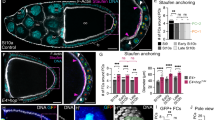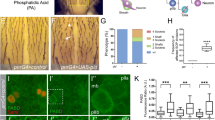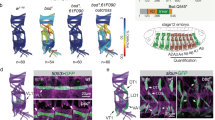Abstract
The mammalian cis–trans prolyl isomerase Pin1 and its yeast orthologue Ess1/Ptf1 have been implicated in cell cycle control but a correlation between biochemical and physiological functions has not been established conclusively. Pin1 targets the proline residue carboxy-terminal to the phosphorylated threonine or serine residue, which constitutes part of the phosphorylated mitogen-activated protein kinase (MAPK) site PXpT/SP. Here we show that the Drosophila Pin1 homologue, the Dodo protein, is involved in dorsoventral patterning of the follicular epithelium in the egg chamber. Its function is to facilitate the degradation of transcription factor CF2, which requires, a priori, activated epidermal growth factor receptor–MAPK signalling.
This is a preview of subscription content, access via your institution
Access options
Subscribe to this journal
Receive 12 print issues and online access
$209.00 per year
only $17.42 per issue
Buy this article
- Purchase on Springer Link
- Instant access to full article PDF
Prices may be subject to local taxes which are calculated during checkout





Similar content being viewed by others
References
Hunter, T. Prolyl isomerases and nuclear function. Cell 92, 141–143 (1998).
Maleszka, R., Lupas, A., Hanes, S. D. & Miklos, G. L. The dodo gene family encodes a novel protein involved in signal transduction and protein folding. Gene 203, 89–93 (1997).
Lu, K. P. Phosphorylation-dependent prolyl isomerisation: a novel cell cycle regulatory mechanism. Prog. Cell Cycle Res. 4, 83–96 (2000).
Lu, K. P., Hanes, S. D. & Hunter, T. A human peptidyl-prolyl isomerase essential for regulation of mitosis. Nature 380, 544–547 (1996).
Hanes, S. D., Shank, P. R. & Bostian, K. A. Sequence and mutational analysis of ESS1, a gene essential for growth in Saccharomyces cerevisiae. Yeast 5, 55–72 (1989).
Crenshaw, D. G., Yang, J., Means, A. R. & Kornbluth, S. The mitotic peptidyl-prolyl isomerase, Pin1, interacts with Cdc25 and Plx1. EMBO J. 17, 1315–1327 (1998).
Shen, M., Stukenberg, P. T., Kirschner, M. W. & Lu, K. P. The essential mitotic peptidyl-prolyl isomerase Pin1 binds and regulates mitosis-specific phosphoproteins. Genes Dev. 12, 706–720 (1998).
Ranganathan, R., Lu, K. P., Hunter, T. & Noel, J. P. Structural and functional analysis of the mitotic rotamase Pin1 suggests substrate recognition is phosphorylation dependent. Cell 89, 875–886 (1997).
Spradling, A. C. in The Development of Drosophila melanogaster. (eds Mate, M. & Martinez-Arias, A.) 1–70 (Cold Spring Harbor Laboratory Press, Cold Spring Harbor, 1993).
Gonzalez-Reyes, A., Elliot, H. & St. Johnston, D. Polarization of both major body axes in Drosophila by gurken-torpedo signalling. Nature 375, 654–658 (1995).
Roth, S., Newman-Silberberg, F. S., Barcelo, G. & Schüpbach, T. Cornichon and the EGF receptor signaling process are necessary for both anterior–posterior and dorsal–ventral pattern formation in Drosophila. Cell 81, 967–978 (1995).
Ray, R. P. & Schüpbach, T. Intercellular signaling and the polarization of body axes during Drosophila oogenesis. Genes Dev. 10, 1711–1723 (1996).
Mantrova, E. Yu. & Hsu, T. Down-regulation of transcription factor CF2 by the Drosophila Ras/MAP kinase signaling in oogenesis: cytoplasmic retention and degradation. Genes Dev. 12, 1166–1175 (1998).
Hsu, T., Bagni, C., Sutherland, J. D. & Kafatos, F. C. The transcription factor CF2 is a mediator of EGF-R-activated dorsoventral patterning in Drosophila oogenesis. Genes Dev. 10, 1411–1421 (1996).
Wasserman, J. & Freeman, M. An autoregulatory cascade of EGF receptor signaling patterns the Drosophila egg. Cell 95, 355–364 (1998).
Sapir, A, Schweitzer, R. & Shilo B.-Z. Sequential activation of the EGF receptor pathway during Drosophila oogenesis establishes the dorsoventral axis. Development 125, 191–200 (1998).
Maleszka, R., Hanes, S. D., Hackett, R. L., de Couet, H. G. & Miklos, G. L. The Drosophila melanogaster dodo (dod) gene, conserved in humans, is functionally interchangeable with the ESS1 cell division gene of Saccharomyces cerevisiae. Proc. Natl Acad. Sci. USA 93, 447–451 (1996).
Fujimori, F., Takahashi, K., Uchida, C. & Uchida, T. Mice lacking Pin1 develop normally, but are defective in entering cell cycle from G(0) arrest. Biochem. Biophys. Res. Commun. 265, 658–663 (1999).
Maleszka, R., de Couet, H. G. & Miklos, G. L. Data transferability from model organisms to human beings: insights from the functional genomics of the flightless region of Drosophila. Proc. Natl Acad. Sci. USA 95, 3731–3736 (1998).
Rebay, I. & Rubin, G. M. Yan functions as a general inhibitor of differentiation and is negatively regulated by activation of the Ras1/MAPK pathway. Cell 81, 857–866 (1995).
Rørth, P., Szabo, K. & Texido, G. The level of C/EBP protein is critical for cell migration during Drosophila oogenesis and is tightly controlled by regulated degradation. Mol. Cell. 6, 23–30 (2000).
Brand, A. H. & Perrimon, N. Raf acts downstream of the EGF receptor to determine dorsoventral polarity during Drosophila oogenesis. Genes Dev. 8, 629–639 (1994).
Neuman-Silberberg, F. S. & Schüpbach, T. The Drosophila dorsoventral patterning gene gurken produces a dorsally localized RNA and encodes a TGF-α-like protein. Cell 75, 165–174 (1993).
Zhou, Z. X., et al. Pin1-dependent prolyl isomerisation regulates dephosphorylation of Cdc25C and tau proteins. Mol. Cell. 6, 873–883 (2000).
Hani, J., Stumpf, G. & Domdey, H. PTF1 encodes an essential protein in Saccharomyces cerevisiae, which shows strong homology with a new putative family of PPIases. FEBS Lett. 365, 198–202 (1995).
Wu, X., et al. The Ess1 prolyl isomerase is linked to chromatin remodeling complexes and the general transcription machinery. EMBO J. 19, 3727–3738 (2000).
Arèvalo-Rodriguez, M., Cardenas, M. E., Wu, X., Hanes, S. D. & Heitman, J. Cyclophilin A and the Ess1 interact with and regulate silencing by the Sin3–Rpd3 histone deacetylase. EMBO J. 19, 3739–3749 (2000).
Perrimon, N., Smouse, D. & Miklos, G. L. Developmental genetics of loci at the base of the X chromosome of Drosophila melanogaster. Genetics (Princeton) 121, 313–331 (1989).
Miklos, G. L. & de Couet, H. G. The mutations previously designated as flightless-I3, flightless-O2 and standby are members of the W-2 lethal complementation group at the base of the X-chromosome of Drosophila melanogaster. J. Neurogenet. 6, 133–151 (1990).
Spradling, A. in Drosophila, a Practical Approach (ed. Roberts, D. B.) 175–198 (IRL Press, New York, 1986).
Acknowledgements
We thank D. Spyropoulos, M. Trojanowska and D. Watson for valuable comments on the manuscript; N. Perrimon for providing the hs-D-rafgof flies; G.L.G. Miklos for the gift of the flightless-I transgenic stocks; and X. Zhang of the Medical University of South Carolina Antibody Production Facility for producing antisera. This work is supported by a grant from the National Institutes of Health to T.H. and a grant from the American Heart Association to H.G.d.G.
Author information
Authors and Affiliations
Corresponding author
Rights and permissions
About this article
Cite this article
Hsu, T., McRackan, D., Vincent, T. et al. Drosophila Pin1 prolyl isomerase Dodo is a MAP kinase signal responder during oogenesis. Nat Cell Biol 3, 538–543 (2001). https://doi.org/10.1038/35078508
Received:
Revised:
Accepted:
Published:
Issue Date:
DOI: https://doi.org/10.1038/35078508
This article is cited by
-
Direct stimulation of ERBB2 highlights a novel cytostatic signaling pathway driven by the receptor Thr701 phosphorylation
Scientific Reports (2020)
-
Prolyl isomerase Pin1: a promoter of cancer and a target for therapy
Cell Death & Disease (2018)
-
Dampened regulates the activating potency of Bicoid and the embryonic patterning outcome in Drosophila
Nature Communications (2013)
-
Molecular mechanisms of EGF signaling-dependent regulation of pipe, a gene crucial for dorsoventral axis formation in Drosophila
Development Genes and Evolution (2012)
-
Fates-shifted is an F-box protein that targets Bicoid for degradation and regulates developmental fate determination in Drosophila embryos
Nature Cell Biology (2011)



